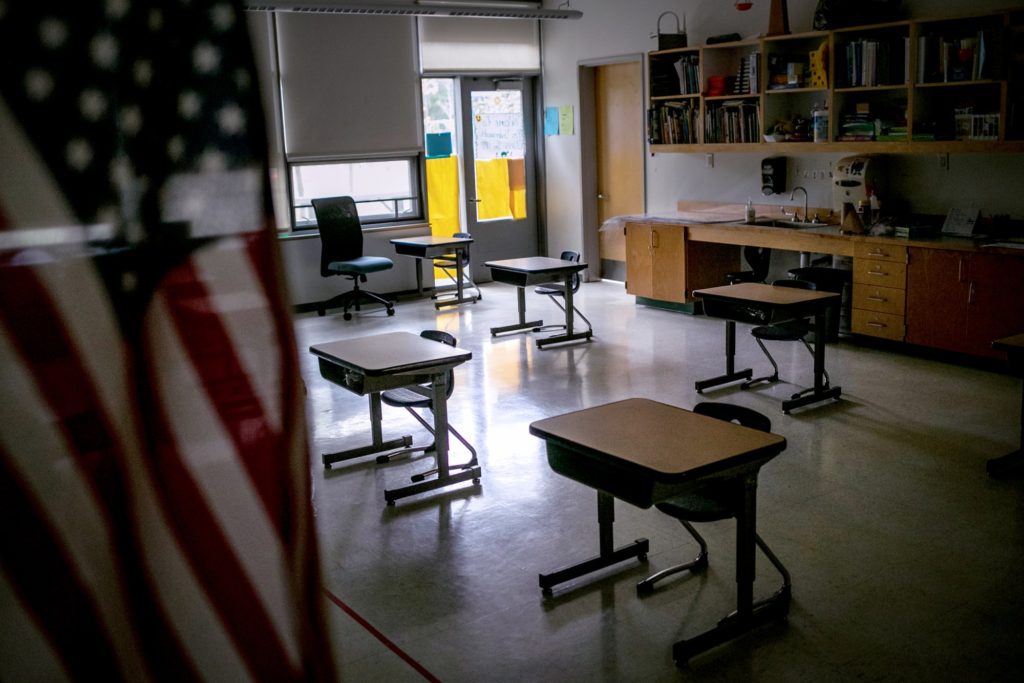福奇:美国人可选择“混打”追加剂
文 / 张佳莹
10/22/2021

(早报讯)美国政府首席传染病专家福奇周五(22日)说,美国人可选择与原来接种不同品牌的冠病疫苗作为追加剂,但仍建议在可行的情况下接种同款疫苗。
福奇在接受美国电视新闻网(CNN)访问时作出上述表示。他说:“但出于某种原因——可能因人、可用性或只是不同的个人选择而存在不同的情况——正如我们所说,你可以混合搭配。”
美国疾病控制与预防中心(CDC)周四批准莫德纳和强生冠病追加剂,并表示美国人可选择与原来接种不同品牌的疫苗作为追加剂。福奇的评论与CDC和美国食品和药物管理局(FDA)本周提出的建议形成对比,后者表示美国人应接种追加剂,但没有说明哪种组合是最好的。
这些建议也意味着,接种单剂量的强生疫苗者可接种一剂辉瑞或莫德纳疫苗,这些疫苗在各种研究中被证明能提供更大的保护。
尽管这些疫苗在预防严重疾病和死亡方面非常有效,但一些政府科学家建议,需要加强免疫以保持高免疫力,特别是由于传染性极强的德尔塔变体可能在一些完成接种者中造成突破性感染。

Tel: 551-580-4856 | Email: F.WINNIE.S@GMAIL.COM
诚招美国和加拿大法律服务代理
因公司发展需要,诚招美国和加拿大法律服务代理。
要求:
懂英语、或西班牙语、或法语。
能合法工作有社安号或工号。
无需改行, 可以兼职。
大学生和有销售经验优先考虑。
自雇生意公司发美国报税1099,加拿大T4A
有意了解详情, 请扫码加微信, 非诚勿扰!

福奇:美国病例激增已达到转捩点 须提高接种率维持趋势
文 / 林煇智
10/03/2021

(早报讯)美国过敏与感染疾病中心主管福奇说,美国最近的冠病激增已达到关键转捩点,但更多民众必须接种疫苗,以保持感染率下降的趋势。
彭博社报道,福奇说,虽然美国全面接种率已经达到55%,但现阶段的主要风险来自美国7000万可以接种,但是还没接种的人。
福奇说:“当然,我们正在扭转这一特殊的激增趋势”。他说:“要确诊率持续下降的方法,就是履行我们一直所提到的事情;接种疫苗。”
自冠病大流行暴发以来,美国死亡人数在上周达到70万起。美国总统拜登称之为“惊人的死亡人数”,再次提醒民众接种疫苗。
Has the spread of Covid-19 peaked in the U.S.? What future Covid spread could look like
New cases have been gradually dropping nationwide, although experts caution that new infections are still at a high rate and further decline will be slow.
By Akshay Syal, MD
9/24/2021
The number of new Covid-19 cases in the United States seems to have peaked, with cases in states hit hard by the delta variant earlier edging downward over the last week, according to an analysis by NBC News. It’s the longest sustained decline in cases in nearly three months, giving hope to some leading pandemic forecasters.
Some hospitals in areas of the country with low vaccination rates are still in crisis mode, but overall the hospitalization rate in the U.S. has dropped, according to the most recent data from the Centers for Disease Control and Prevention.
This week, Covid deaths in the U.S. topped 685,027, more than the estimated 675,000 people who died during the 1918-19 Spanish flu pandemic. On Thursday, Florida, a delta variant hot spot, tied its seven-day reported deaths average set two days before, with 376 lives lost.
Further drop in the number of new Covid cases will be stubbornly slow, experts warn. Yet, there are glimmers of light.
New Covid cases reached a high point Sept. 13, with a seven-day average of cases at 166,807, NBC News data finds. Since then, cases have been gradually dropping nationwide for seven of the last eight days. It’s the most consistent decline since June 23, a time period before the delta variant took hold in the U.S.
“There’s pretty decent agreement that we’re at the peak in cases nationally,” said Shaun Truelove, assistant scientist at Johns Hopkins Bloomberg School of Public Health. “There’s quite a bit of variability between states, but as a whole, it seems that we’re at or near the peak of this thing.”
It will not be a sharp decline like we saw a sharp rise.
Truelove is part of a team that works on the COVID-19 Scenario Modeling Hub, a series of models that estimates the trajectory of the virus at both national and local levels. Based on Johns Hopkins projections, cases will continue to decline nationally until at least January 2022, the end point of its current estimates.
Truelove is cautiously optimistic about the coming months. “Barring any rapid new change to the virus, that’s kind of the direction we’re going to continue to go — downward,” he said.
A ‘slow burn’ of high case counts
Ali Mokdad, chief strategy officer at the Institute for Health Metrics and Evaluation at the University of Washington in Seattle, is also hopeful that — although there may be increases in cases in areas of low vaccination — cases nationally should continue to decline in the near future.
However, he projects a “slow burn” of relatively high case counts.
For full coverage of the coronavirus pandemic
“It will not be a sharp decline like we saw a sharp rise,” Mokdad warned.There could be a bump around the December holidays due to seasonality of the virus, potential relaxation of physical distancing measures, and any waning immunity from the vaccines, he said.
The current surge of cases, driven by the delta variant, took off rapidly earlier this summer to the surprise of many infectious disease modelers.
“The delta variant has been really challenging to predict,” Truelove said. “Initially we didn’t think [cases] were going to go as high as they did.”
He is hopeful that although there may be increases in cases in areas of low vaccination, nationally cases should continue to decline in the near future. According to the CDC, more than 182 million people, about 55 percent of the U.S. population, are fully vaccinated against Covid.
Jeffrey Shaman, an infectious disease modeler at Columbia University, agreed that for the current surge, the peak in cases appears to be over. However, he cautioned that because death counts tend to lag case counts by weeks, the U.S. could still see deaths rise in the next few days before peaking.
“I would imagine that it’s going to be next week that we’re probably going to see the peak of deaths nationally,” he said. “There may be some wiggle room there, but generally I’d say two to four weeks after the peak of cases, you can expect to see the peaks of deaths.”
Shaman is hopeful that despite the lifting of public health measures in certain areas, the U.S. will follow the path of his models and continue to see a downward trajectory in cases over the coming weeks and months.
“We have some governors and officials who are doing what seems to be their best to create conditions that are conducive for the spread of the virus,” he said, referring to the lack of mask mandates and even the outlawing of school mask mandates in certain states.
The Covid forecasters are very careful about saying whether the end of the pandemic in the U.S. is near. The ferocious spread of the delta variant in the country over the summer caught many by surprise.
“It was quite shocking,” Truelove said. “That’s just the nature of this pandemic. It just keeps throwing us curve balls that we wouldn’t have expected and they continue to challenge us.”
He warned that projections could be thrown off by colder weather and the ever present potential for a new variant to emerge.
“Who knows what other variants are going to come around, or if we’re going to have some surge for other reasons that we’re really not anticipating at this point,” Truelove said.
Schools grapple with thousands in isolation or quarantine as delta variant rages
Many schools that planned to forgo virtual and hybrid learning this year, in favor of in-person classes, are revisiting those plans as outbreaks require students to quarantine.
By Daniella Silva
9/05/2021

Schools that have opened their doors to students amid the spread of the highly contagious delta variant of the coronavirus already are grappling with how to best continue teaching students when hundreds and sometimes thousands of them are in quarantine.
As cases of Covid-19 started to wane over the spring and the early summer, many schools planned to forgo virtual and hybrid learning this year, in favor of in-person classes. But the lag in vaccination rates and the rapid spread of the delta variant have led districts to revisit those plans, with varying results.
Some schools have sent students home with packets of self-guided work to submit at the end of each day or when on-campus classes resume. Others have temporarily switched to virtual learning. And in some cases, schools have canceled classes altogether while campuses are closed or kids are in quarantine.

In Mississippi, officials last month said more than 20,000 students were in quarantine from exposure to the coronavirus after the first week of school.
The high quarantine numbers among students and staff members led at least 29 schools to “go virtual for a short time in order to interrupt transmission,” the state’s epidemiologist said.
Similarly, the Connally Independent School District in Texas, which opened to students Aug. 18, closed its schools for in-person classes Tuesday after two teachers died last week of Covid. The five schools in the suburban Waco district hastily switched to remote learning and are scheduled to reopen for in-person learning after Labor Day.
“If this pandemic has taught us one thing, it is the ability to change directions quickly,” Connally Elementary School Principal Eric Cantu wrote in a note to parents on the district’s website. “Going from Face to Face learning to remote learning is an example of this.”
More than 300 miles east, however, in Iraan, Texas, learning was put on hold for two weeks when schools closed because of a Covid outbreak in August, about a week into the school year.
Iraan-Sheffield Independent School District Superintendent Tracy Canter said in the letter to the school district’s community Aug. 16 that neither virtual nor remote learning would take place during the closure, but that teachers would be available by email.
She said schools would still meet the minimum 75,600 minutes of instructional time required by law, in part by turning two early-release days into full days of school.
“We know that this is difficult for everyone involved and we thank you for your support and patience during this unprecedented time,” Canter said in the letter.
School districts are confronting the dilemma of how to keep the school year going as the number of parents who want their children to go to in-person school drops.
Only 43 percent of public school parents and guardians said they wanted their children in a classroom full time this year after the Centers for Disease Control and Prevention on July 27 updated its health guidance to recognize the threat of the delta variant.
That was down from 58 percent of parents and guardians who said they wanted in-person instruction before July 27, according to a survey funded by the CDC through the Atlanta-based nonprofit CDC Foundation. It polled 1,448 public school parents and guardians July 23-Aug. 8.
Just more than half of the nation’s largest 100 school districts are planning to make a remote learning option available to all students, according to the University of Washington’s Center on Reinventing Public Education, while 92 will offer some type of remote instruction.
In Florida’s Hillsborough County Public Schools, thousands of students have been quarantined since the start of the school year in August.
Teachers are putting lessons and instructional material online for kids in quarantine and sending out electronic devices or providing physical copies of work based on student need, Jennifer Sparano, the district’s Covid coordinator, said.
She said work is done independently, with check-ins from teachers, but the district is looking into hiring teachers and support staff to be available online during the day to give children live access to a teacher if their own ones are not available because they are teaching in a classroom.
There were more than 7,380 reported Covid cases and nearly 9,270 students and staff in isolation or quarantine, as of Friday, according to a district dashboard. Last Friday, there were more than 5,270 reported Covid cases and nearly 12,000 students and staff in isolation or quarantine, according to the dashboard. The total district population is more than 240,000.
A symptom-free student could still be out of school for five to seven days, under the district’s quarantine procedures, though Sparano said said many students don’t typically miss five full days of school.
In Metro Nashville Public Schools in Tennessee, from Aug. 9 to Aug. 15, there were 95 staff who were isolated or quarantined, with 52 confirmed cases and 980 students were isolated or quarantined, with 207 confirmed cases. From Aug. 16 to Aug. 22, there were 143 staff isolated or quarantined, with 67 confirmed cases and 2,879 students isolated or quarantined, with 395 confirmed cases, according to Sean Braisted, the district’s executive officer of communications and community engagement.
Isolated or quarantined students can access their course information and assignments online and the district offers remote learning assistance to students, he said in an email. Parents must also verify a student participated in all instructional activities, he said.
In the Northeast, where many schools don’t reopen until after Labor Day, school districts are announcing return plans that include planning for continuing education in quarantine.
New York City, which houses the nation’s largest school system and where all public school teachers and staff must get vaccinated, is planning to try to limit the number of students who have to quarantine.
In elementary schools, a classroom will be required to quarantine for 10 calendar days in the event of a positive test in that class and students will continue to receive instruction while they quarantine. But in middle and high schools, students who are at least 12 years old, vaccinated and not showing symptoms will be allowed to continue to attend school in-person. Students who are at least 12 years old, vaccinated and showing symptoms will have to quarantine for 10 calendar days and will have access to remote learning while quarantining. Unvaccinated students will have to quarantine for 10 calendar days, continue learning remotely, and will be allowed to return with a negative result after the seventh day.
The city’s strategy is designed to avoid the disruption of major school closures, which would be necessary only in case of widespread transmission in the school, the New York City Department of Education said in a health and safety guide.
“Our commitment to parents is to minimize disruption this year, keep as much continuity as possible and make sure all those health and safety measures are in place,” New York City Mayor Bill de Blasio said.




